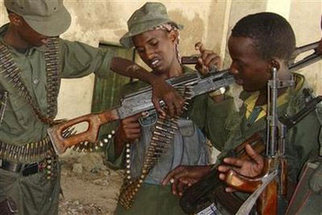Top al Qaeda militant killed in Somalia
MOGADISHU: US special forces in helicopters attacked a car in southern Somalia on Monday and killed one of east Africa's most wanted al Qaeda militants, witnesses and US sources said.
A senior Somali government source said the fugitive was in a car with other foreign insurgents from the al Shabaab rebel group when they were hit near Roobow village in Barawe District, some 250 km (150 miles) south of the capital Mogadishu.
Washington says al Shabaab is al Qaeda's proxy in Somalia.
"Nabhan and four other top foreign commanders ... were killed in the raid," the government source said.
"They are in confusion now. I hope the world takes action."
US sources familiar with the operation, speaking on condition of anonymity, said the United States believed Nabhan had been killed and his body had been taken into US custody.
Pentagon spokesman Bryan Whitman declined to comment "on any alleged operation in Somalia".
Western security agencies say the failed Horn of Africa state has become a safe haven for militants, including foreign jihadists, who use it to plot attacks in the region and beyond.
Nabhan, who has long been on the Federal Bureau of Investigation's Most Wanted list, is believed to have fled to Somalia after the 2002 bombing of the Israeli-owned beach hotel.
AL QAEDA SUSPECTS
The United States says another leading al Qaeda suspect who may be in Somalia, Sudanese explosives expert Abu Talha al-Sudani, is believed to have orchestrated those two attacks.
The US military has launched air strikes inside Somalia in the past against individuals Washington blames for the bombings of the US embassies in Kenya and Tanzania in 1988.
In May last year, US warplanes killed the then-leader of al Shabaab and al Qaeda's top man in the country, Afghan-trained Aden Hashi Ayro, in an attack on the central town of Dusamareb.
Under Ayro, al Shabaab had adopted Iraq-style tactics, including assassinations, roadside bombs and suicide bombings.
Several residents said they believed some French commandos had been involved in Monday's operation in Barawe, but a defense ministry spokesman in Paris denied any involvement.
French forces have also launched raids inside Somalia in the past to rescue French nationals held by rebels and pirates. Paris has a large military base in neighboring Djibouti.
Last month, one of two French security advisers kidnapped by Somali insurgents in July managed to escape from his captors and fled to the presidential palace in Mogadishu.
His colleague is still being held by al Shabaab, and some Somalis feared he would be killed in revenge for Monday's raid.
Somali President Sheikh Sharif Ahmed's administration controls only small parts of the nation's drought-ridden region and a few districts of the bullet-scarred coastal capital.
Violence has killed more than 18,000 Somalis since the start of 2007 and driven another 1.5 million from their homes.
That has triggered one of the world's worst aid emergencies, with the number of people needing help leaping 17.5 percent in a year to 3.76 million, or half the population.



























